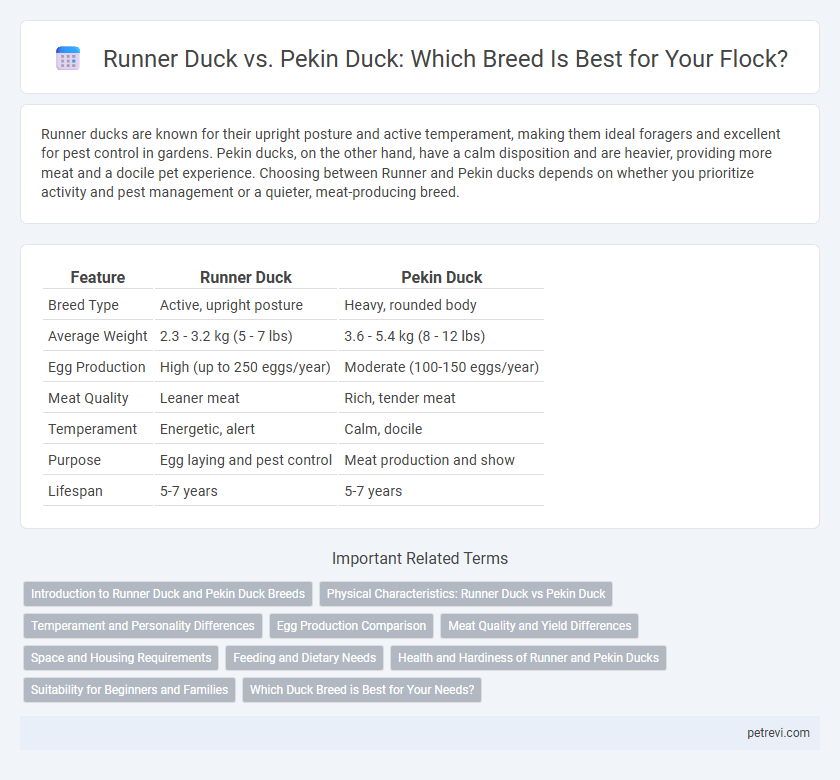Runner ducks are known for their upright posture and active temperament, making them ideal foragers and excellent for pest control in gardens. Pekin ducks, on the other hand, have a calm disposition and are heavier, providing more meat and a docile pet experience. Choosing between Runner and Pekin ducks depends on whether you prioritize activity and pest management or a quieter, meat-producing breed.
Table of Comparison
| Feature | Runner Duck | Pekin Duck |
|---|---|---|
| Breed Type | Active, upright posture | Heavy, rounded body |
| Average Weight | 2.3 - 3.2 kg (5 - 7 lbs) | 3.6 - 5.4 kg (8 - 12 lbs) |
| Egg Production | High (up to 250 eggs/year) | Moderate (100-150 eggs/year) |
| Meat Quality | Leaner meat | Rich, tender meat |
| Temperament | Energetic, alert | Calm, docile |
| Purpose | Egg laying and pest control | Meat production and show |
| Lifespan | 5-7 years | 5-7 years |
Introduction to Runner Duck and Pekin Duck Breeds
Runner Ducks are a distinctive breed known for their upright posture and vigorous foraging behavior, often used in pest control due to their active nature and prolific egg-laying capacity, producing around 150-200 eggs annually. Pekin Ducks, originating from China, are favored for their large size, calm temperament, and rapid growth, commonly bred for meat production with adult weights reaching up to 10 pounds. Both breeds offer unique advantages depending on farming goals, with Runners excelling in mobility and egg output while Pekins provide substantial meat yield and easy handling.
Physical Characteristics: Runner Duck vs Pekin Duck
Runner Ducks exhibit a slender, upright posture with long legs and a narrow body, making them agile and fast walkers. Pekin Ducks have a robust, rounded body with a broad chest and short legs, giving them a heavier and more grounded appearance. The contrasting physical features of Runner Ducks and Pekin Ducks influence their suitability for different environments and purposes.
Temperament and Personality Differences
Runner ducks exhibit a more active and energetic temperament, often exploring and foraging vigorously, making them suitable for pest control and lively environments. Pekin ducks display a calmer and more docile personality, which aligns well with domestic settings and families seeking a gentle, easy-to-handle breed. Their differing temperaments influence breed selection based on lifestyle preferences and purposes such as companionship, egg production, or meat.
Egg Production Comparison
Runner ducks typically produce 150-200 eggs per year, making them highly efficient layers compared to Pekin ducks, which average 100-120 eggs annually. The eggs of Runner ducks tend to be smaller and more frequent, ideal for consistent egg supply, while Pekin ducks lay larger eggs but with lower frequency. For egg production-focused breeding, Runner ducks offer superior output and are preferred in commercial settings for their prolific laying capacity.
Meat Quality and Yield Differences
Runner ducks typically offer leaner meat with a milder flavor, making them suitable for lighter dishes, while Pekin ducks provide a richer, fattier meat favored for traditional roast preparations. Pekin ducks generally yield higher meat volume due to their larger size and faster growth rates, making them preferred in commercial meat production. Choosing between them depends on desired meat texture and quantity, with Pekin excelling in yield and Runner offering distinctive meat quality.
Space and Housing Requirements
Runner Ducks require less space per bird compared to Pekin Ducks, making them ideal for smaller housing environments or urban settings. Pekin Ducks, being larger and heavier, need more spacious housing with robust fencing to accommodate their size and reduce stress-related behaviors. Proper ventilation and dry bedding are essential for both breeds to maintain health and prevent diseases in confined spaces.
Feeding and Dietary Needs
Runner ducks require a higher-protein diet compared to Pekin ducks due to their increased activity levels and leaner body composition. Pekin ducks thrive on a balanced diet rich in grains and greens, as they are less active and tend to gain weight easily. Both breeds benefit from supplementation with vitamins and minerals to support growth, feather health, and overall immunity.
Health and Hardiness of Runner and Pekin Ducks
Runner Ducks exhibit robust health and exceptional hardiness, thriving in diverse climates due to their active nature and disease resistance. Pekin Ducks, while generally hardy, are more prone to obesity and related health issues if not exercised regularly, requiring careful management to maintain optimal health. Choosing between Runner and Pekin ducks depends on the desired balance between active resilience and temperament suited for different duck-keeping environments.
Suitability for Beginners and Families
Runner ducks are highly active and agile, making them excellent for beginners who have ample outdoor space and enjoy observing lively behavior. Pekin ducks are calmer and more docile, ideal for families seeking low-maintenance pets that adapt well to confined areas and interact gently with children. Both breeds are hardy and relatively easy to care for, but Pekins typically require less supervision, enhancing their suitability for novice keepers and family environments.
Which Duck Breed is Best for Your Needs?
Runner Ducks excel in egg production, laying up to 250 eggs annually, making them ideal for those prioritizing fresh eggs. Pekin Ducks are larger and meatier, often preferred for meat production due to their rapid growth and tender flesh. Choosing between Runner and Pekin Ducks depends on whether your primary goal is high egg yield or substantial meat quality.
Runner Duck vs Pekin Duck for Duck Breed Selection Infographic

 petrevi.com
petrevi.com